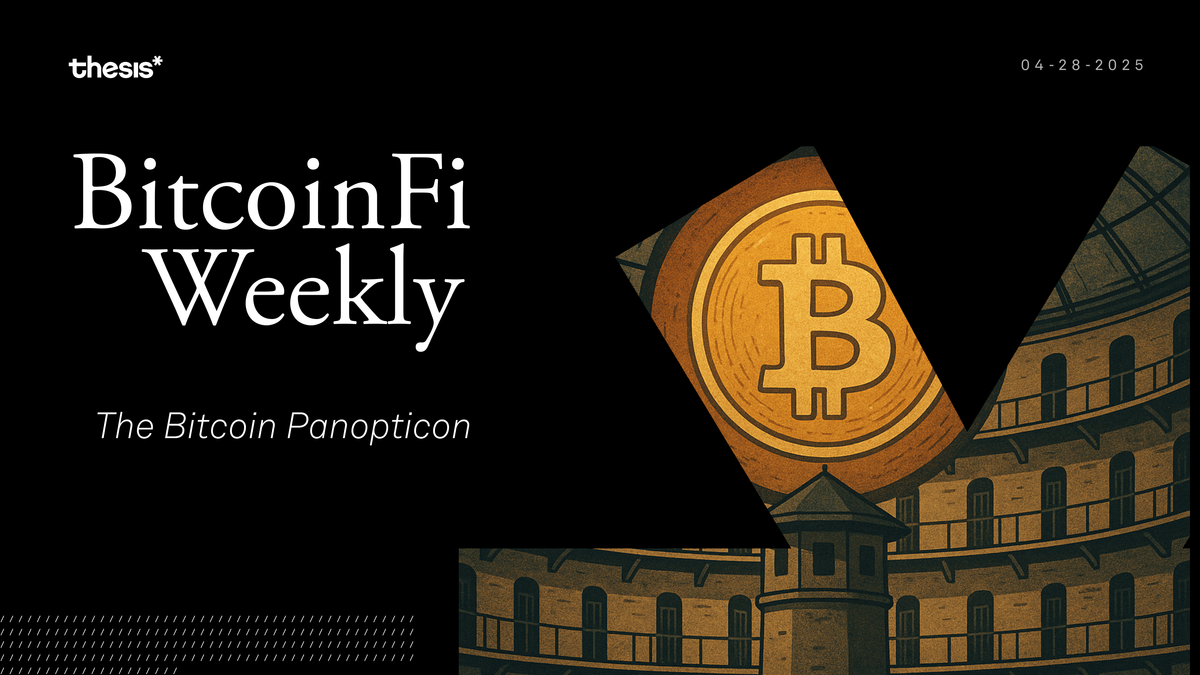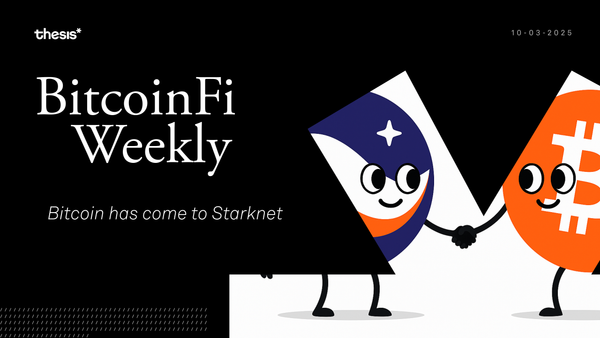The Bitcoin Panopticon
This week, BitcoinFi Weekly covers Bitcoin’s messy progress: sharpened privacy debates, new stablecoin launches, easing crypto rules, and institutional Bitcoin strategies. Real change is happening — but it's uneven, fragile, and full of new risks.

Welcome to BitcoinFi Weekly. We cover where people use their BTC and what is changing in the Bitcoin world.
One of Bitcoin’s oldest myths is that progress would be obvious when it arrived — clean upgrades, unstoppable adoption, smooth consensus. This week shows a different reality: progress looks messy, fragile, and often uncomfortable. Privacy debates sharpen, and capital markets edge closer with new structures like Twenty One, but not without new risk. Regulators back off from crypto supervision — just as builders introduce stablecoins directly into Bitcoin’s base layer. The ground is moving, but it’s uneven. Let’s dive in.
Here’s this week’s rundown:
🏛️ Feature piece: The Bitcoin Panopticon
💵 Spark Unveils New Stablecoin
🏦 Fed Eases Crypto Rules
🧪 Ark Prototypes Tokenized VTXOs
🎯 Twenty One Gives Strategy a Run for Its Money
Feature Piece
Bitcoin was born from the idea of freedom. However, its original architecture leaned heavily toward radical transparency. Every transaction made on the Bitcoin network is permanently recorded on a public ledger. What once seemed like a way to build trust without intermediaries has instead created an immutable trail that anyone with the right tools can trace. Early believers recognized this flaw and realized that Bitcoin's openness, often praised for combating fraud, risked becoming a powerful surveillance machine. The assumption was that privacy could be bolted on later. Years passed, and that never happened.
The transparency baked into Bitcoin’s design exposes sender-receiver relationships, transaction histories, and behavioral patterns. Companies specializing in chain analysis raised hundreds of millions of dollars to map out Bitcoin's network. Governments developed tools to deanonymize users at scale. Meanwhile, Bitcoin’s public ledger, intended to empower individuals, increasingly served those who could exploit its openness for control. Bitcoin without strong privacy protections does not resist surveillance; it enables it.
Efforts to improve Bitcoin’s privacy fell short of the need. Protocols like CoinJoin attempted to mix transactions together to confuse observers, but their early implementations had significant weaknesses. WabiSabi, a more sophisticated attempt at flexible, private transaction coordination, was designed to address many of these flaws. WabiSabi’s key designers sought to make coinjoin transactions more private by introducing arbitrary denominations and anonymous credentials. However, despite the careful design, the team implementing these protocols often cut corners. At zkSNACKs, basic operational missteps (like improper server logging) undermined user privacy. Technical mistakes piled up, from poor coin selection strategies to fragile coordination models. In the rush to ship products, critical privacy principles were neglected.
These failures were compounded by economic and social pressures. True privacy adds complexity to systems and user experience. It slows growth metrics that startups depend on. Businesses optimizing for frictionless adoption treated privacy as an afterthought, betting that users would not demand it. For the most part, they were right. Many users not only ignored privacy but treated it as suspicious. Exchanges became increasingly hostile toward users who leveraged privacy tools, refusing service or closing accounts based on the mere use of mixing protocols. The result was a chilling effect: privacy became stigmatized, reinforcing its marginalization.
The technical challenges of Bitcoin privacy are real. High-privacy systems often complicate key management, degrade performance, and introduce new vulnerabilities. But the greater challenge is cultural. Without user demand, developers have little incentive to endure the costs and risks of building strong privacy features. Without normalization, regulators and companies continue treating privacy protections as a threat rather than a baseline.
Bitcoin without privacy is not financial freedom. It is financial exposure. A system that reveals every payment, purchase, and transfer to the world does not empower its users; it catalogs them. The initial dream of sovereignty cannot survive if privacy remains optional. It must be foundational. Builders must design with privacy in mind from the start, not defer it to an imagined future. Users must exercise their right to privacy now, not wait until the consequences are irreversible. Some progress has been made at the base layer: the Taproot upgrade, activated in 2021, slightly reduced the amount of information exposed on-chain by making certain types of transactions look more uniform. Taproot proved that careful protocol improvements can enhance privacy without sacrificing Bitcoin’s security model. But Taproot alone was a small step, not a solution.
The surveillance state has already arrived, and Bitcoin’s current design offers little resistance. If privacy is not protected at the protocol, product, and user level, Bitcoin risks becoming the very system it was meant to overthrow. The choice is no longer theoretical. It is immediate. Bitcoin must evolve toward privacy, or it will be used against the people it was meant to serve.
BitcoinFi Updates
Coinbase Bitcoin Yield Fund
Coinbase will launch the Bitcoin Yield Fund (CBYF) on May 1, 2025, targeting institutional investors with projected net annual returns of 4%–8% paid in Bitcoin. The fund’s primary strategy is basis trading, capturing price spreads between Bitcoin’s spot and futures markets, with future expansions planned into lending and options. Risk management emphasizes avoiding speculative lending, using third-party custodians for secure asset storage, and applying controlled leverage to limit counterparty exposure. Investors can subscribe or redeem monthly with a five-day notice, and Coinbase aims to grow the fund to $1 billion in assets under management.
CBYF contrasts with failed, centralized platforms like BlockFi by prioritizing conservative strategies rather than high-risk lending. However, narrowing spreads and margin pressure during Bitcoin price surges may challenge the sustainability of returns. Aspen Digital, an Abu Dhabi-based firm, serves as the fund’s seed investor and exclusive distributor across the UAE and Asia.
Spark Unveils New Stablecoin
Spark and Brale have partnered to launch Bitcoin-native fiat-backed stablecoins, demoing the first time regulated stablecoins can operate directly on Bitcoin’s base layer without relying on sidechains or Layer 2s. Using Spark’s infrastructure, transactions settle with instant finality and negligible fees, while Brale handles licensing, custody, and regulatory compliance through a developer-facing API. The stablecoins will also be compatible with Bitcoin’s Lightning Network, enabling real-time micropayments and cross-border transactions.
Early adopters like Flashnet are building real-time settlement products using Brale-issued stablecoins on Spark. But the tradeoffs are real. Spark’s infrastructure is young, unproven at large scale, and success depends heavily on Brale’s custody and compliance layers, introducing new trust assumptions into Bitcoin's traditionally minimized trust model. It will be interesting to see how the markets react to this product and if the 200 million+ user base represents the TAM they want to go after.
Fed Eases Crypto Rules
The Federal Reserve Board announced it is withdrawing its prior guidance related to banks' crypto-asset and dollar token activities. Specifically, the Fed rescinded its 2022 requirement that state member banks provide advance notification before engaging in crypto-related activities and removed its 2023 supervisory nonobjection process for dollar token activities. Banks ' crypto-asset activities will now be monitored through the normal supervisory process rather than require additional approvals.
The Fed, along with the FDIC, is also withdrawing from two 2023 joint statements on banks’ crypto exposures, aligning with the Office of the Comptroller of the Currency (OCC). The agencies indicated they will continue evaluating whether new guidance on crypto activities is needed, but the immediate effect is to lower procedural barriers for banks engaging with crypto and stablecoins. Banks no longer need to seek advance approval for crypto-asset or dollar token activities and will instead be monitored through standard supervisory processes. This doesn’t mean regulators are embracing crypto, but it does remove an extra layer of procedural friction that had effectively discouraged bank participation.
Ark Prototypes Tokenized VTXOs
Ark has completed a prototype integration of Lightning’s Taproot Assets into its protocol, enabling tokenized VTXOs (tVTXOs) that carry both Bitcoin and token commitments within Ark’s offchain transaction batches. This system uses Taproot’s internal key and TapTree structures to embed asset data without altering Ark’s existing mechanics. The Colored Trees framework powers the integration. Colored Trees works by extending Ark's offchain batching system to support both Bitcoin and Taproot Asset tokens simultaneously. Colored Trees mark transactions with asset commitments while maintaining standard batch behavior and unilateral exit guarantees, enabling atomic Bitcoin-token flows without requiring new consensus rules or sidechains.
The proof-of-concept includes a CLI tool for batch construction, integration with tapd for asset issuance, and a dockerized test environment, demonstrating end-to-end flows from onboarding to unilateral exits. By embedding token proofs directly into Ark’s offchain transaction flows, Taproot Assets can use Bitcoin’s security model without introducing sidechains or breaking consensus rules.TLDR: By embedding asset commitments directly into offchain transaction trees, Ark manages to extend functionality without introducing sidechains, bridges, or new trust assumptions — a notable contrast to many previous attempts to "bring assets to Bitcoin."
Twenty One Gives Strategy a Run for Its Money
Jack Mallers announced the launch of Twenty One, a Bitcoin-native company aimed at offering capital markets direct exposure to Bitcoin ownership per share (BPS) while developing Bitcoin-specific financial tools. Mallers will lead Twenty One alongside his existing role as CEO of Strike. The firm will initially be seeded with $3 billion in Bitcoin, contributed by Tether ($1.5 billion), SoftBank ($900 million), and Bitfinex ($600 million), and plans to go public via a SPAC merger under the name 21 Capital.
Twenty One is positioning itself as a direct competitor to MicroStrategy, but with a leaner, Bitcoin-native structure aimed at maximizing Bitcoin per share. By seeding with $3 billion in Bitcoin contributions from Tether, SoftBank, and Bitfinex, and minimizing debt at launch, Twenty One aims to avoid the dilution and diminishing returns issues that have increasingly challenged MSTR’s model. Unlike MicroStrategy, whose scale forces it to absorb large tranches of Bitcoin with smaller marginal impact, Twenty One will start with a smaller base and a capital-efficient design.SoftBank’s $900 million Bitcoin investment marks its largest Bitcoin bet to date, following a prior $200 million Bitcoin purchase and subsequent loss in 2017. Managing public investor expectations while operating on a Bitcoin standard introduces volatility risk that traditional capital markets may struggle to digest. Mallers’ dual leadership of Strike and Twenty One adds operational complexity at a moment when both companies will need focus to scale.
Closing Thoughts
The story this week is not of easy victories, but of complicated progress. Privacy, once dismissed as a detail, now stands revealed as Bitcoin’s unfinished foundation. Institutions once wary are edging closer, bringing capital and pressure in equal measure. New stablecoin models and asset frameworks are pushing Bitcoin’s limits, but not without introducing new kinds of risk. Even regulators seem unsure whether to step forward or retreat. Bitcoin’s growth, like all human endeavors, carries within it both the seeds of liberation and the quiet machinery of its own betrayal.
It would be comforting to believe that progress is inevitable and that truth, once glimpsed, cannot be lost. But history teaches otherwise. Still, despite the weight of doubt and the certainty of struggle, there remains a stubborn faith — that if enough care is taken, if enough vigilance is kept, Bitcoin can yet remain what it was born to be: a refuge in a world that forgets freedom. We watch, we build, we doubt, and we continue.
Thank you for tuning in to this week’s BitcoinFi Weekly. See you next week.
If there's a topic you’d like us to cover or have questions, reach out at [email protected].





